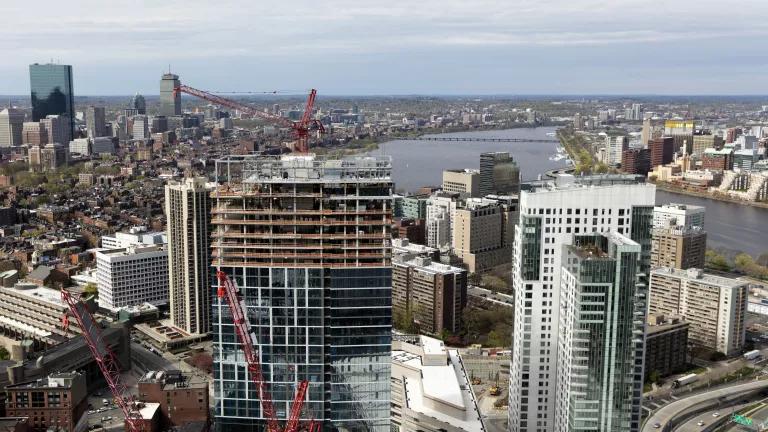Charlotte Gets Its Moment in the Sun with New Solar Project
Charlotte's city council voted to approve a new utility-scale solar project that will supply 25% of municipal energy.

Logan Cyrus for NRDC
The forecast for Charlotte, North Carolina, just got a whole lot sunnier. The Charlotte City Council voted to approve a new 35-megawatt, utility-scale solar project that will offset 25 percent of emissions from city-owned buildings.
What was one small step for the City Council is one giant leap for the city’s climate goals. Charlotte’s Strategic Energy Action Plan, adopted in 2018, set an ambitious target to get 100 percent of the energy for its municipal buildings from zero carbon sources by 2030. By approving Charlotte’s opting in to the Duke Energy Green Source Advantage project, the City Council’s vote gets Charlotte a quarter of the way there in one fell swoop.
Utility Green Tariffs
Charlotte is using a novel route to go solar. The city is acquiring its renewable energy by using a utility green tariff. These programs, offered by utility companies, allow large customers to purchase renewable energy from a specific project. The city is partnering with Carolina Solar Energy and Ecoplexus to build the utility-scale project that Charlotte will source its’ energy from in nearby Iredell County. For the City of Charlotte, the solar project purchase agreement is at a fixed rate that will allow the city to realize $2 million in long-term savings on energy costs.
With this vote, Charlotte becomes the 16th largest city in the U.S. and the most populous American city to acquire renewable energy through a utility green tariff.
In Charlotte’s case, the utility is Charlotte-based Duke Energy, and the program it offers is called Green Source Advantage (GSA). Charlotte tapped into the GSA’s allocation for large business customers in North Carolina (which is fully subscribed and has a waiting list). Thanks to Charlotte’s leadership, other North Carolina municipalities have reached out to learn from the City’s experience so they can pursue their own renewable energy opportunities. With the popularity of the GSA program, and a rapidly growing demand for clean energy from businesses, municipalities, and residents, what can Charlotte and other large customers expect next from Duke Energy?
A Low Carbon Future
Charlotte is one of many cities across the country—and world—to recognize that even when federal governments won’t take bold climate action, local governments can, and should.
Mayor Dan Clodfelter signed the Global Covenant of Mayors for Climate & Energy in 2015; Mayor Vi Lyles and former Mayor Jennifer Roberts re-upped the city’s commitment to climate leadership by signing the “We Are Still In” declaration to deliver on the promises of the Paris Climate Agreement; now, Charlotte is one of 25 cities participating in the American Cities Climate Challenge.
The city outlined specific steps to meeting these commitments in the Strategic Energy Action Plan (SEAP). The framework identifies 11 Action Areas focused on transportation, buildings, energy generation, and workforce development and equity.
In 2015, Charlotte emitted 12 tons of carbon dioxide per person, and it’s dedicated to leaving that number firmly in the past. The 11 Action Areas are designed to shift the city into a low carbon future and toward its goal of emitting less than 2 tons of carbon dioxide per person by 2050.
Leading by Example
Reining in emissions to below 2 tons of carbon dioxide per capita means the SEAP is a decidedly community-wide effort. But the plan recognizes the importance of the city leading by example and taking a long, hard look at its internal operations first. That’s why Action Area 5 of the plan is “Strive Toward 100% Zero Carbon Municipal Buildings By 2030.”
It makes good sense to home in on buildings, which account for 48 percent of all emissions in Charlotte. The city of Charlotte is working to reduce municipal building energy use as an effective strategy toward reaching zero carbon buildings. The city’s efforts demonstrate the types of tools that the community-wide effort will also need. Investments in both energy efficiency and adding new sources of clean renewable energy are essential for the community to get closer to reaching the city’s ambitious per capita carbon goals.
Clean Air Strategy that Generates Jobs and Saves Money
The impact of offsetting 25 percent of city building emissions adds up in important ways. The 35-megawatt solar project will generate enough energy annually to power 10,000 homes, while simultaneously improving air quality—the equivalent to taking 12,000 passenger cars off the road. Not only is it a win-win for the global atmosphere and local lungs, but the project is expected to create 428 jobs while saving the city $2 million in energy expenses.
The city expects the solar project to be fully operational by 2022. Charlotteans: Here’s to brighter days ahead!




